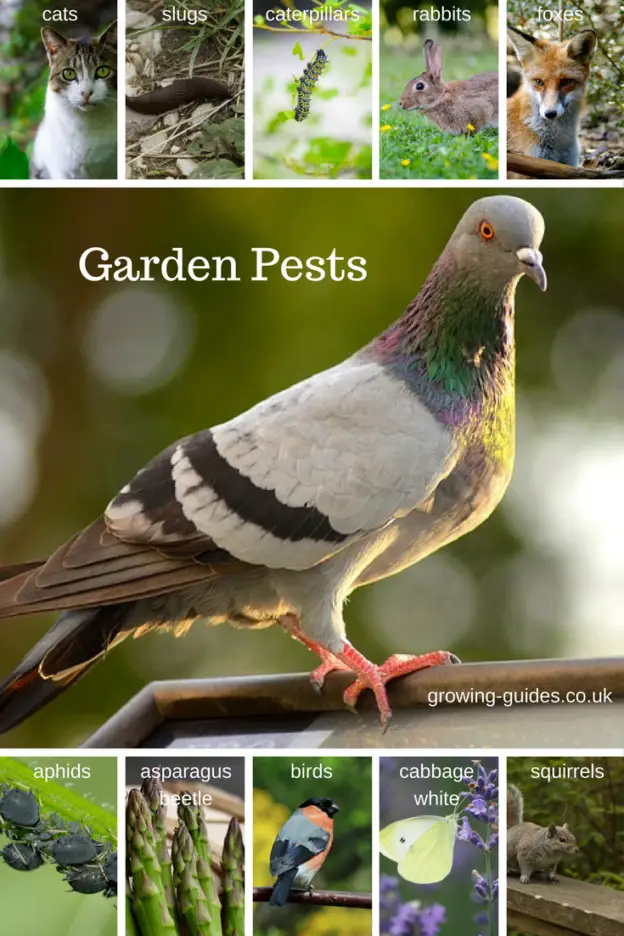Quite a few people have recently been asking me about how to prevent garden pests, so this post is my reply.
Garden Pests
The garden will never be free from pests but with enough knowledge damage can be kept to a minimum. Never has the old saying “prevention is better than cure” been more apt than in the garden. Another old but true saying is “knowledge is power” so lets arm ourselves with a little knowledge.
Know Your Enemy
Garden pests come in all shapes and sizes. Ranging from Aphids to Foxes and all sizes in between. They all attack your plants in different ways and can all cause devastation on your plot. Some damage is inevitable but keeping it to a minimum is our aim, so our first course of action is observation.
By regularly observing what’s going on in the vegetable garden we can identify and take steps to lessen any attacks from garden pests. From the minute that a seed is sown it is under threat from one predator or another. So as soon as the seedlings appear they need constant monitoring.
Identifying Common Garden Pests
Once a problem is spotted it needs to be dealt with. Knowing what we are dealing with makes it easier to control the problem.
Aphids
There are many different types of aphids including, greenfly and blackfly. Not many vegetable plants are safe from aphid attack including :-
- Beans
- Cabbage
- Lettuce
- Tomatoes
Aphids are prolific breeders and are even known to clone in extreme circumstances. Not only do they damage plants by sucking life giving sap from plants, but they also spread viral diseases. Ants actually farm aphids, carrying them to plants and encouraging them to produce their sticky, honeydew.
Treatment
Companion plant with relevant flowers to encourage Ladybirds, Hoverflies, and Lacewings. In some cases there are resistant varieties that can be grown. Try using horticultural fleece to cover plants, or use soft soap or insecticidal soap to wash aphids off plants.
Cabbage Root Fly
The maggot of the cabbage root fly attacks all Brassicas including :-
- Cabbages
- Cauliflowers
- Broccoli
- Brussel Sprouts
- Turnips
- Swede
The maggots bore through the plant and overwinter in the soil. If a plant gets attacked by cabbage root fly the plant will in most cases wilt and die.
Treatment
Protect the stems of plants with cardboard covers or discs of carpet placed around them at ground level. Cover plants with a fleece. Once crops have been harvested, dig over the soil to expose maggots and attract birds.
Cabbage White Caterpillars
The cabbage white caterpillars can completely destroy young plants in a very short time.
Treatment
Peel off with a gloved hand to prevent them from burrowing into the plants. To prevent attacks cover young plants in fine mesh fleece.
Carrot Fly
The tiny carrot fly is easy to miss yet the grub can devastate a crop of carrots. Sadly once the wilting tops are spotted it’s too late.
Treatment
Companion planting with strong smelling plants like onions, leeks and garlic can help but the best protection I have found is fleece. Carrot flies are reported to not be able to fly higher than 12 inches so a barrier placed around rows of carrots might be effective. However fleece takes all the guess work out and protects carrots, parsnips and celery.
Asparagus Beetle
This yellow and black beetle can ruin your asparagus bed by stripping the foliage completely off the plants.
Treatment
Pick them off by hand or spray with insecticidal spray. Keep beds clear of weeds and debris to discourage beetle infestation.
Red Spider Mite
These insects attack plants primarily in greenhouses, causing plants leaves to curl, brown and die.
Treatment
Red spider mites thrive in dry conditions so spray plants regularly with water and you can use insecticidal soap if necessary.
Slugs
Slugs eat twice their body weight daily and are attracted to many vegetables including:-
- Cabbages
- Lettuces
- Most Tender Seedlings
Warm, moist conditions bring slugs out at night and they spend their days under stones, wood, rotting plants, leaves, and debris.
Treatment
Encourage birds, frogs, slow worms,and hedgehogs. Keep growing areas free from rubbish, and use dry mulches like wood chips. Other options include beer traps and crushed egg shells but the only effective slug control is late night sorties into the garden with a torch and a bucket.
Birds
There are birds like pigeons that will decimate most crops, especially when the weather is cold and frosty. There are other birds that will eat all your fruit from gooseberries to raspberries and from apricots to apples.
Treatment
To prevent bird damage cover crops in netting. Either draped over the crops or supported on posts. Home made bird scarers made out of old CDs hung on string blowing in the wind will help as well.
Rabbits and Squirrels
Rabbits eat all brassicas and salad leaves and also digging through the soil. Squirrels will nibble at everything and also uproot onions and garlic.
Treatment
Fence building is the only way with these creatures. Chicken wire with a mesh size of no more than 1 inch. At least 4 foot high with approximately 8 inches underground at about a 45 degree angle.
Cats and Foxes
Cats tend to treat the entire plot as a litter tray which is not pleasant when rooting through the soil and you find a handful. Foxes will dig holes in the soil looking for worms and grubs, uprooting plants as they go.
Treatment
A solid fence is the best solution but it needs to be both strong and high keep cats out. You can also try leaving clear plastic bottles filled with water lying around the plot these are supposed to spook cats.
Some scents can be used to deter some garden pests for more information click here.
So that’s the growing-guides guide to garden pests. If you have any other solutions please leave a comment below.

